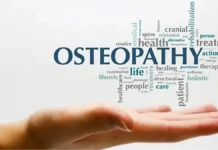Introduction
Osteopathy, a term derived from the Greek “osteon” meaning structure and “pathy” evoking suffering, constitutes a holistic therapeutic approach centered on understanding the body as a whole. Based on the principle that the physical, mental and emotional aspects are interconnected and contribute to a person’s suffering, osteopathy aims to restore balance in these different areas to promote health and well-being.
Osteopathy practitioners use various manual techniques to achieve these goals. These techniques include methods such as stretching, gentle pressure, and resistance, individually adapted based on each patient’s specific needs. The personalized approach distinguishes osteopathy, where each treatment is tailored to the unique condition of each individual.
Osteopathy particularly focuses on the musculoskeletal system, including the joints, muscles and spine. By acting on these elements, osteopaths aim to optimize overall health by positively influencing the nervous, circulatory and lymphatic systems of the body. Harmony and physiological balance are at the heart of these interventions, and the primary objective is to provide relief while promoting the body’s natural recovery.
The philosophy of osteopathy is based on the belief that the body has an innate capacity to self-regulate and self-heal. By eliminating obstacles that hinder this ability, osteopaths seek to create an environment conducive to optimal health. This often results in manual adjustments aimed at correcting biomechanical imbalances, improving blood and lymphatic circulation, and reducing muscle tension.
Osteopathy is not limited to treating specific symptoms, but focuses on identifying and understanding the underlying causes of health disorders. Osteopaths carry out in-depth assessments to determine potential dysfunctions in the body, seeking to resolve problems at their source rather than simply treating symptoms in isolation.
As a holistic approach, osteopathy also recognizes the importance of mental and emotional aspects in overall health. Stress, repressed emotions and other psychological factors can influence how the body functions. Therefore, osteopaths consider these aspects in their overall approach, seeking to restore balance both physically and mentally.
In conclusion, osteopathy represents a comprehensive approach to health, emphasizing the connection between body, mind and emotions. Using appropriate manual techniques, osteopaths seek to restore balance, optimize bodily function and promote the body’s natural ability to self-heal. This holistic view makes it a valuable discipline in promoting health and well-being.
Four principles of osteopathy
Osteopathy is based on four fundamental principles formulated by its founder, Andrew Taylor Still. These principles provide the philosophical and conceptual framework that guides osteopathic practice. Here are the four principles of osteopathy:
The Law of Artery governs Health
This principle emphasizes the importance of blood circulation and lymphatic flow for health. According to this principle, adequate blood supply is essential to maintain tissue health and promote the healing process. Osteopaths seek to improve circulation by working on the structure of the body to promote optimal blood flow.
Structure Governs Function
This principle suggests that the anatomical structure of the body directly influences its function. Osteopaths believe that structural restrictions or imbalances can hinder the body’s normal functioning and contribute to health problems. By correcting these imbalances, it is hoped to restore normal function.
The Rule of Body Unity
According to this principle, the body is considered as an integrated functional unit. Parts of the body are interconnected, and problems in one area can impact other parts of the body. The osteopath evaluates the body as a whole to identify the relationships between the different structures and treat the person as a whole.
The Body’s Self-Regulating Capacity
This principle emphasizes the body’s intrinsic ability to self-heal. Osteopaths consider that the body has a natural capacity to self-regulate, self-heal and maintain a homeostatic balance. Osteopathic interventions aim to support this ability by removing structural obstacles that could hinder the healing process.
These principles establish the theoretical bases of osteopathic practice. Osteopathy is a holistic approach that seeks to understand and treat the whole person, taking into account the complex interactions between the structure and function of the body.
Therapeutic approach
There are a variety of osteopathic techniques, and practitioners may use different approaches depending on the patient’s specific needs and their training. Here is a non-exhaustive list of some of the most commonly used osteopathic techniques:
- Joint Manipulation:
- Joint mobilization: Gentle movements to improve joint mobility.
- Joint manipulation: Rapid, controlled movements to restore normal joint function.
- Soft Tissue Techniques:
- Massage: Manipulation of soft tissues to relax tense muscles.
- Muscle stretching: Techniques aimed at increasing muscle flexibility.
- Myofascial Release:
- Manipulation of connective tissue layers (fascia) to improve mobility and reduce restrictions.
- Cranial Osteopathy:
- Gentle manipulation of the skull to influence the circulation of cerebrospinal fluid and restore balance.
- Visceral Manipulation:
- Gentle manipulation of internal organs to improve mobility and function.
- Muscle Energy Techniques:
- Controlled and active use of the patient’s muscles to reduce tension and improve mobility.
- Joint Positioning Techniques:
- Place the joint in a specific position to promote healing.
- Neuromuscular Inhibition:
- Application of pressure or resistance to relax muscles and normalize neuromuscular function.
- Strain Counterstrain:
- Positioning the body in a comfortable position to relieve muscle spasms.
- Exercises and Tips:
- Prescription of specific exercises to strengthen muscles and improve posture.
- Advice on ergonomics, nutrition and other aspects of lifestyle.
Conclusion
In conclusion, osteopathy, anchored in its founding principles, offers a complete and holistic approach to health promotion. Beyond the “Law of the Artery governs Health”, three other fundamental principles guide this discipline.
“Structure governs Function” highlights the importance of structural balance for optimal physiological function. By working to restore alignment and mobility of tissues, osteopathy is committed to promoting a state of well-being by allowing the body to function harmoniously.
The “Rule of Articulation” highlights the central role of joints in the overall mobility of the body. Osteopaths use targeted manual techniques to restore joint mobility, reduce tension and realign structures, thus contributing to better coordination of movements.
Finally, the principle of “The Wholeness of the Individual” underlines the holistic approach of osteopathy, which considers the body as a whole. By examining the complex interaction between different systems of the body, this discipline personifies the concept of patient-centered health care, taking into account the medical history, lifestyle and specific needs of each individual.
These principles, combined, reaffirm osteopathy’s commitment to restoring the body’s natural homeostasis. By adopting this holistic approach, osteopathy offers a nuanced alternative for those seeking personalized, integrated health care focused on promoting total health.

























